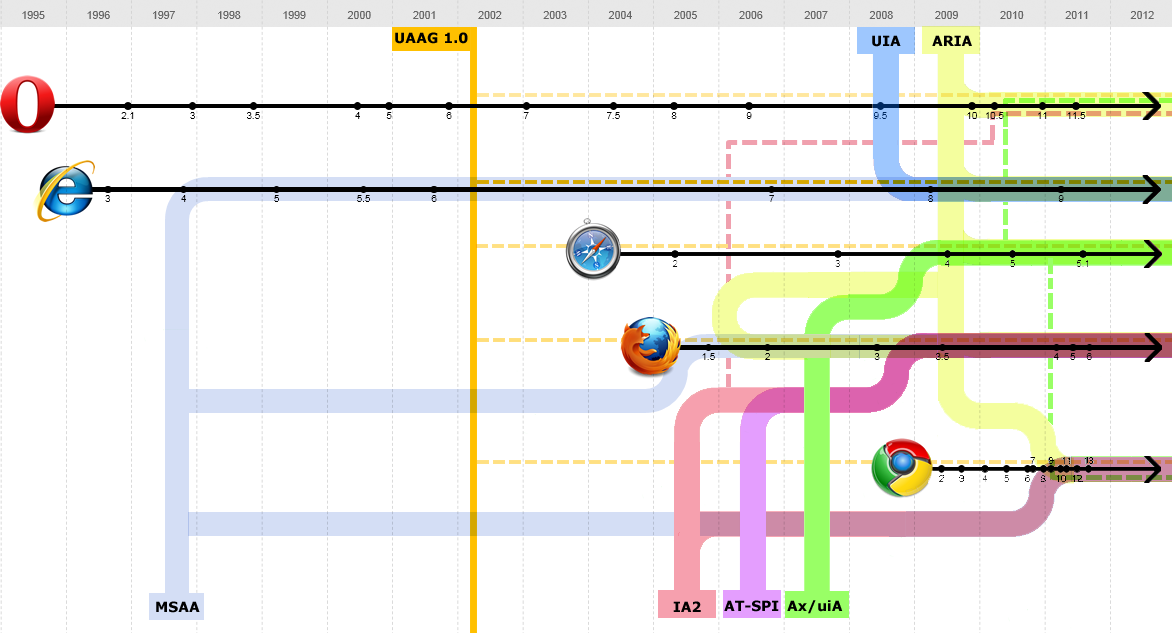back to article
A brief history of browser accessibility support
Infographic
legend
Unbroken lines represent practical support
Broken lines represent initial or partial support
Glossary of terms
ARIA
Accessible Rich Internet Applications 1.0 (cross platform)AT-SPI
Assistive Technology Service Provider Interface (Linux)Ax/uiA
The Mac OS X Accessibility Protocol (Mac OS X)Introduction to Accessibility Programming Guidelines for Cocoa (Mac OS X)UIAccessibility Protocol Reference (iOS)IA2
Iaccessible2 (Windows/Linux)MSAA
Microsoft Active Accessibility (Windows)UAAG 1.0
User Agent Accessibility Guidelines 1.0 UIA
Microsoft UI Automation (Windows)VPAT
Voluntary Product Accessibility Template
Timeline: Brief history of browser accessibility support
1996
Opera 2.1 released.
Internet Explorer 3 released.
1997
Opera 3
Internet Explorer 4
Support for Microsoft Active Accessibility (MSAA) implemented in Internet Explorer.
1998-2001
Opera 3.5, 4, 5 and 6 releases.
Internet Explorer 5, 5.5 and 6 releases.
UAAG Conformance Evaluation(27 August 1999 Draft) of Opera 3.6, Internet Explorer 5 and Netscape 4.08.Implementation report for User Agent Accessibility Guidelines 1.0 User Agent Implementation Report for Second Candidate Recommendation
Internet Explorer 6.0 for Windows 9x/Me/2000/XP (HTML 4.01, CSS1, CSS2 and SMIL 2.0)
GW-Micro Window-Eyes (with Internet Explorer 5.5) 4.11 for Windows (HTML 4.01, CSS1 and CSS2 )
JAWS (with Internet Explorer 6.0) 4.02 for Windows 9x/Me/2000/XP (HTML 4.01, CSS1, CSS2 and SMIL 2.0)
Opera Browser 6.0 for Windows (HTML 4.01, CSS1 and CSS2)
Mozilla Browser 0.9.9 for Windows (HTML 4.01, CSS1 and CSS2)
IBM Home Page Reader 3.02 for Microsoft Windows (HTML 4.01, CSS1 and CSS2)
Internet Explorer 5.0 for Macintosh OS 9.x (HTML 4.01, CSS1 and CSS2)
2002
User Agent Accessibility Guidelines 1.0 (UAAG 1.0) released: The User Agent Accessibility Guidelines (UAAG) documents explain how to make user agents accessible to people with disabilities, particularly to increase accessibility to Web content. User agents include Web browsers, media players, and assistive technologies, which are software that some people with disabilities use in interacting with computers.Mozilla's UAAG Evaluation Report For Mozilla the Browser on Microsoft Windows UAAG Implementation Review of Opera Browser 6.0 UAAG Implementation Review of Internet Explorer 6.0 2003
Opera 7
Netscape announces industry standard accessibility support for Netscape browser
2004
Safari 1
Opera 7.5
UAAG 1.0 Test Suite for HTML 4.01 UAAG 1.0 Test Suite for SVG 1.1 2005
Opera 8
Safari 2
Firefox 1.5
Microsoft's new accessibility model, UI Automation 2006
Opera 9
Internet Explorer 7
Internet Explorer 7.0 VPAT (word doc.) Firefox 2
Firefox 2 VPAT Firefox: An open source accessibility success story Firefox: Initial implementation of ARIA (early draft).
Completing the Windows accessibility picture - IAccessible2 2007
Safari 3
2008
Opera 9.5
Firefox 3
Firefox 3: implemented AT-SPI support.
2009
Opera 10
Opera 10: Initial ARIA implementation.
Internet Explorer 8
Internet Explorer 8 VPAT (word doc.) Internet Explorer 8: Initial implementation of UI automation.
Internet Explorer 8: Initial implementation of ARIA.
Safari 4
Safari 4: Initial ARIA support implemented
AX Accessibility Protocol support in Safari 4
UI Accessibility Protocol implemented in iOS 3Firefox 3.5
Firefox 3.0, 3.5 and 3.6 VPAT Chrome 1, 2 and 3
2010
Opera 10.5 and 11
Opera 10.5: Initial AX accessibility support implemented.
Report of a partial Iaccessible 2 implementation in Opera
Safari 5
Safari 5: improved ARIA support.
Chrome 4, 5, 6, 7 and 8
Chrome 4, 5, 6, 7 and 8: initial MSAA, IA2 and ARIA support.
2011
Opera 11.5
Internet Explorer 9
Internet Explorer 9: improved ARIA support.
Internet Explorer 9 VPAT (word doc.) Safari 5.1
Safari 5.1: further improvements in ARIA support.
Firefox 4, 5, 6 and 7
Firefox 4, 5, 6 and 7: improvements in IA2, AT-SPI and ARIA support.
Chrome 9, 10, 11, 12, 13 and 14
Chrome 9, 10, 11, 12, 13 and 14: initial AX accessibility support, improvements in MSAA, IA2 and ARIA support.
Chrome Accessibility Design Document (for developers)Chrome has partial screen reader support on Windows and Mac.
Chrome VPAT Implementing UAAG 2.0 (draft) - A guide to understanding and implementing User Agent Accessibility Guidelines 2.0
